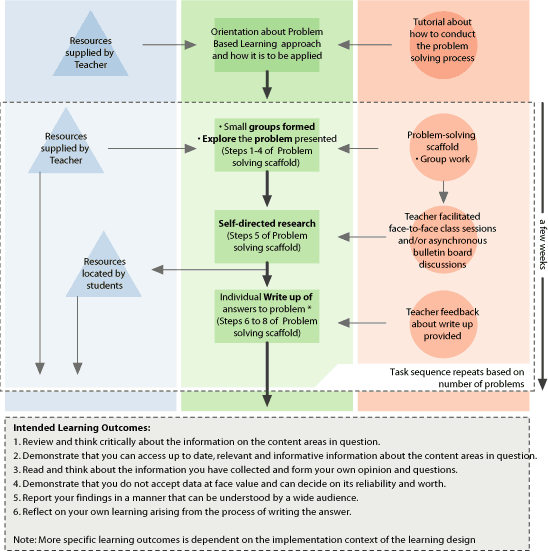|
STUDENT SUPPORTS
1. The learning guide
"The Approach" is a significant scaffold/support
provided to the students. More specifically, the Approach:
1. meets the situation (scenario);
2. defines the situation;
3. gathers the facts:
- identify relevant experience and knowledge;
- identify what you need to know (further information and
learning);
- identify potential information/learning resources (place
ideas in 5);
4. generates relevant questions from the previous section:
- for you to go away and answer before next class;
- for me to go away and answer in next class.
(Steps 1 to 4 will be covered in class for the on-campus
students. For the off-campus students steps 3 and 4 are covered
online via the Bulletin Board)
5. Research required (Type of…);
6. an individual student 6-page write-up where they:
- rephrase the situation (refine the original question statement);
- generate answers (select possible, probable and preferable
explanations);
- advocate answers (choose the "best" answer and
justify it).
2. Online discussion
This allows the students to raise questions for which they
realise more information will enhance their understanding
of the situation and how it is developing. Also by reading
other people’s questions they can come to a shared idea
about the situation and this tends to affirm what they believe
is going on, so usually builds their confidence that they
are on the right track to solving the problem.
3. Face-to-face class
Internal students are also supported by attending and participating
in class where relevant material is discussed.
4. Role of instructor
The role of the instructor is very important, and supports
the student learning in several ways: by providing instruction
on the learning process as well as resources to assist the
learning; and by providing feedback on student performance
which is completed in a timely fashion, and posted on the
Bulletin Board within 2 weeks of the assignment submission.
The students also receive individual guidance on the marking
sheet.
On-campus students meet the situation (weeks 2, 6 and 10
of the semester) in class and discuss it in small groups of
around six people following steps1 to 4 of the approach outlined
above. A week later in class the teacher provides a reply,
which answers and summarises the student questions.
Off-campus students follow the same approach, except that
they discuss as individuals the questions they would like
to ask of the teacher on the Bulletin Board in the week following
the introduction to the situation. The teacher then responds
and on the Bulletin Board provides a reply, which answers
and summarises the student questions. On-campus students also
have a "dry run" early in the learning event with
a situation that is probably more familiar to them before
going through the approach in class that exemplifies the thinking
and questioning skills required. This is also done to relieve
their anxiety in a learning activity they are not familiar
with.
The off-campus students have some explanation of PBL in the
handbook (hard copy and online), but it is necessary to have
a follow-up session on what PBL is and how it supports learning,
as there are critical misconceptions and misunderstandings
amongst the students. The third activity of PBL is introduced
and questions raised are responded to. All statements and
replies are available as hard copy as well as online.
OPTIONAL SUPPORTS, SIGNIFICANCE OF SUPPORT STRATEGIES
Some of the hard copy material could be optional.
The significance of the support strategies is that without
them the students would have no scaffolding to support their
learning, and for those (the majority) who have never experienced
PBL this aspect is very important. The support framework enables
students to build confidence in their problem-solving ability
especially for those students who are less familiar with the
content material and its meaning.
|
